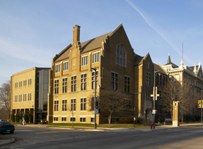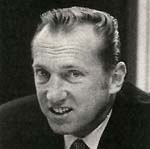Remembering Year 2 in Sensenbrenner Hall
 As we settle into the second year of Eckstein Hall, it is interesting to look back and try to imagine what it would have been like to have been a student in Sensenbrenner Hall in its second year, 1925-1926.
As we settle into the second year of Eckstein Hall, it is interesting to look back and try to imagine what it would have been like to have been a student in Sensenbrenner Hall in its second year, 1925-1926.
First of all, the Sensenbrenner Hall of 1925 was quite different from the building that the law school vacated in July of 2010. The original building, known only as the Law Building until the 1950’s and constructed for the princely sum of $200,000, contained 5540 square feet of space (not counting the basement). The building ran for 100 feet along Wisconsin Avenue and for 60 feet along Eleventh Street, but a 10′ by 46′ indention at its southwest corner kept it from being perfectly symmetrical.
Not only was the then-new law building just the front part of current structure, but its interior was also arranged quite differently from the way that we remember it. Its principal components were three classrooms, two courtrooms, a palatial reading room, the library stacks, and a variety of offices.
As one entered the building from W. Wisconsin Avenue, the room on the first floor to one’s immediate right was a lecture hall.
On the left hand side of the hallway were an office and a faculty room/lounge. Beyond the lounge and the northeast lecture hall were four more offices, two on each side, and another lecture hall on the west side of the building.
The east side of the second floor was the moot court room, in which mock cases were tried before “Judge” Dean Schoetz each Thursday during the school year. Opposite it were another office and a jury room. The western half of the floor was divided between a classroom in the northwest corner and the appellate courtroom opposite it on the southwest side of the building.
On the east side of the third floor was found the luxuriously appointed Grimmelsman Memorial Reading Room, which had been funded by a separate gift of $50,000 from the Cramer family in honor of one of the University’s earlier presidents. (The Cramers were apparently promised that the name of the room would never be changed.) On the opposite side of the floor were the stacks that constituted the school’s library. In addition to a center hallway, the third floor also included two offices.
In the basement, one could find a smoking room in the west third of the building with the rest of the space divided between the janitor’s room, a locker room, and an “unassigned” room.
The two biggest academic changes between 1924 and 1925 came from the law school’s decision to eliminate its night division and to require all first year students to have completed two years of college before enrolling in the law school..
For the first time in the school’s 17-year history all first-year students in 1925 were full-time students. Moreover, full-time students now had to present evidence of two years of college work, not just one as had been the case in 1924.
Although currently enrolled night students were allowed to finish their course of study in the evening, these two changes caused the school’s overall enrollment to drop sharply from 325 students in the fall of 1924 to 235 in the fall of 1925. First year enrollment, not surprisingly, was down significantly, as only 39 new freshmen law students enrolled under the more rigorous entrance requirements.
Enrollment would drop even further to 203 students in 1926. (By way of comparison, total enrollment at the University of Wisconsin Law School in 1924-25 was 240 students.) The elimination of the night program did make Marquette eligible for ABA accreditation, which it received in 1925, two years after the American Bar Association began to accredit law schools.
While most of the law students were male, there were a handful of female students, including Lois Kunzli, who sat on the board of directors of the Coed Club, the leading campus women’s organization.
The faculty was made up of 17 professors, five of whom — Dean Max Schoetz, John McDill Fox, Willis Lang, A.C. Umbreit, and Carl Zollman — were full-time teachers. The part-time instructors included Wisconsin Supreme Court Justice Franz Eschweiler, Municipal Judges A.C. Backus and Otto Briedenbach, and Thomas Lyons, the former chairman of the Wisconsin Tax Commission.
Students in 1925 paid $85 per semester in tuition, plus a $3 health service fee each semester. Books were projected to cost $40 in the first year, $25 in the second, and $30 in the third. Students were advised that “Good board can be secured near the Law School at $5.50 to $7.50 per week. Students who club together can board for less.” Legal education, it seems safe to say, was less expensive in the old building.
Marquette graduates in 1925 and 1926 were still required to take the Wisconsin bar examination, but that was okay with Dean Max Schoetz who was an outspoken opponent of the diploma privilege and who supported efforts to have it abolished in Wisconsin.
In summing up the second year of student life in the new law building, the Hilltop, the Marquette yearbook, noted, “Under the direction of Dean Max Schoetz, Jr., the school of law has become one of the most active and enthusiastic departments in the university. During the past year the students in the law school were represented in almost every phase of student life. The lawyers began their year’s activity by winning the Homecoming Trophy for the best float in the parade. On the athletic field, Lavern Dilweg, junior barrister, won recognition for the school of law by being place on Walter Eckersall’s All-American team [for college football].” (Dilweg, an end, went on to star for the Green Bay Packers and later was elected to Congress.)
The law school’s basketball team, also starring Dilweg, won the university intramural championship, and two members of the varsity golf team, including captain Leonard Fons, were law students. A debate team, composed entirely of law students, defeated the team from Cambridge University during its American tour.
A picture of the new law building with an inset of the chandelier and stained glass window from Grimmelsman Reading Room were set out on page 19 of the yearbook. The annual law dance, held in the Knights of Columbus ballroom on January 22, 1926, was reported on page 108. The Law Review, in its sixth year of operation was led by editor-in-chief John M. O’Brien.
With a brand new law building, a day-only student body, new entrance requirements that were exceeded by only a handful of American law schools, and a full-time faculty that included Carl Zollman, one of the best known legal scholars in the United States, AALS membership, and ABA accreditation, the Marquette Law School was well-positioned to take a place among the leading law schools of the 1920’s.


